I’ve always been fascinated by the idea that a single tweet can move markets. When Elon Musk tweets about Tesla, Dogecoin, or even a random meme, the financial world pays attention.
During my own research on the connection between social media and stock prices, I realized I needed to systematically study his tweets. The problem? Manually scrolling through timelines wasn’t going to work.
That’s when I discovered the power of exporting tweets. With the right tools, you can collect, filter, and analyze tweets for insights that matter—whether you’re studying markets, researching public sentiment, or tracking brand performance.

Why Export Tweets?
Exporting tweets isn’t just for data scientists—it’s useful for anyone who wants to turn Twitter into an actionable research tool:
❇️ Researchers: Analyze public opinion on politics, economics, climate, or social issues.
❇️ Marketers: Track customer reactions to campaigns or new product launches.
❇️ Investors: Measure the market impact of tweets from influential figures like Elon Musk.
❇️ Individuals: Back up their own tweets or analyze which ones perform best.
📌 Real example: During the pandemic, researchers exported millions of tweets about lockdowns and vaccines. The analysis gave governments real-time insight into public fears, trust levels, and misinformation patterns.
The Problem with Manual Collection
❌ Twitter doesn’t provide an easy way to bulk export tweets.
Manually copy-pasting tweets is time-consuming, timelines are limited, and advanced filtering is nearly impossible.
If you want to see long-term patterns—or match tweets against external data like stock prices—you need a faster, structured approach.
The Solution: Circleboom Twitter
That’s where Circleboom Twitter comes in.

As an official partner of Twitter/X, it’s safe, API-compliant, and designed for large-scale analysis.
With Circleboom, you can:
✅ Export your own or other accounts’ tweets.
✅ Apply filters by date, keyword, hashtag, or engagement.
✅ Download tweets in CSV or Excel format.
✅ Keep permanent archives for research or backups.
Instead of wasting hours, you can gather data in minutes.
Step-by-Step: How to Export Tweets
Step #1: Enter the Username
On the Circleboom export page, type in the Twitter/X username of the account you want to export tweets from (without the “@” symbol) and click on the blue “Search” button.

Step #2: Confirm the Tweet Count
Circleboom will display the total number of tweets available for export from the selected account. Review this information, then click the “Next” button to proceed with the export process.
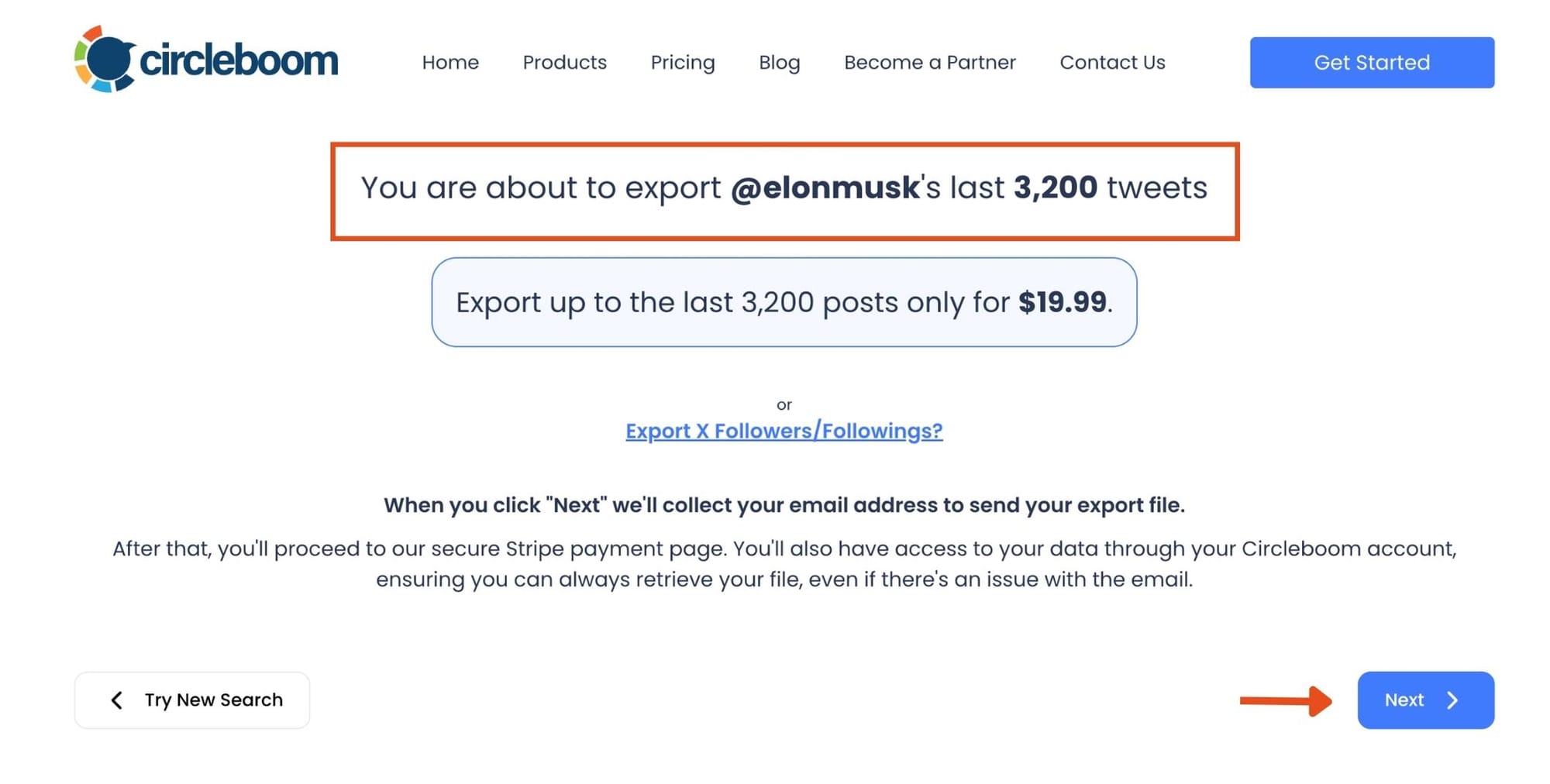
Step #3: Enter Your Email Address
Enter the email address where you’d like to receive the exported tweet file. Circleboom also recommends creating an account for easy access to your export file at any time. After entering your email, click the “Next” button to continue.
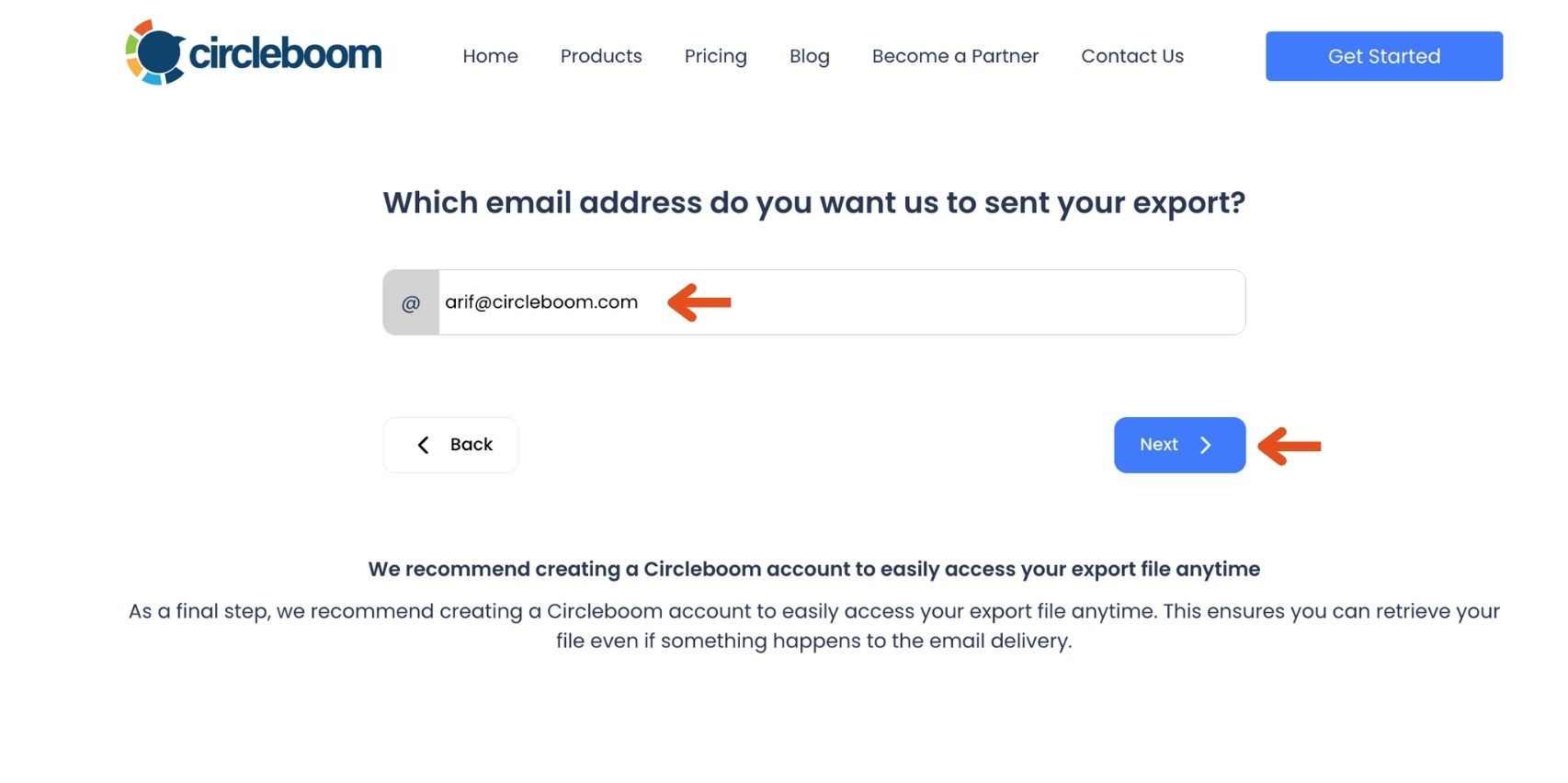
Step #4: After entering your email address, Circleboom sends the exported tweets in a CSV format directly to your inbox.
This CSV file includes essential details like Post ID, username, tweet text, engagement metrics (likes, retweets, replies), language, and timestamps, making it easy to review, analyze, or archive the tweets.
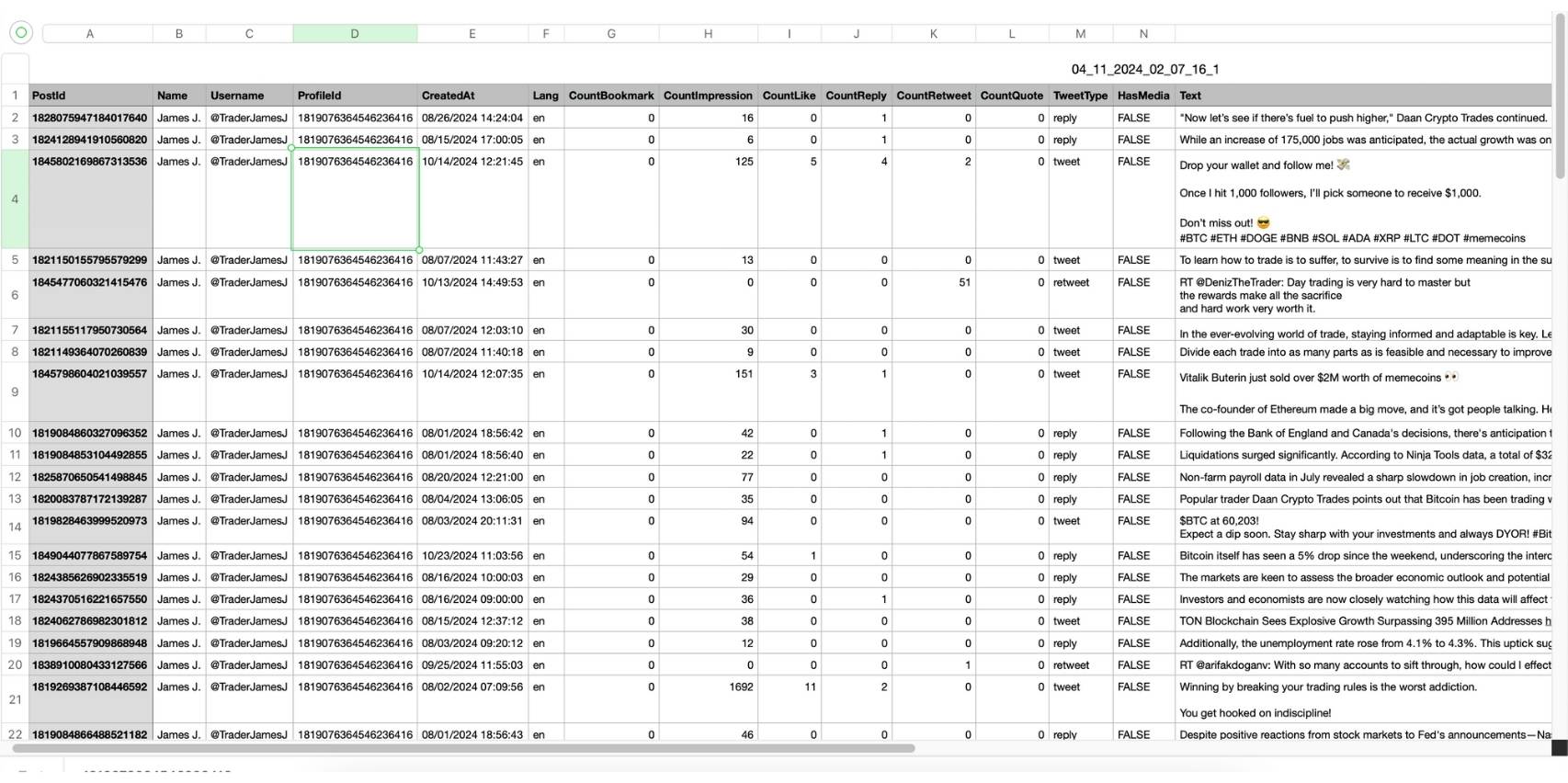
The process is straightforward, and Circleboom does all the heavy lifting, delivering your data in a neatly organized format.
Here's how you can export all tweets of someone. Watch the video 📥 ⬇️
How to Analyze Exported Tweets
Exporting tweets gives you raw data—but analysis is where the magic happens. Here are the most effective methods:
1. Frequency Analysis (What Are the Dominant Topics?)
- What to do: Count recurring words, hashtags, or mentions.
- Why it matters: Identifies major themes and communication focus.
📌 Example: Exporting Elon’s tweets might reveal spikes in “AI” and “sustainability” during 2023, highlighting his shifting priorities.
💡 Pro Tip: Create a word cloud for a quick visual of the most repeated terms.
2. Sentiment Analysis (Tone of Voice Over Time)
- What to do: Classify tweets as positive, negative, or neutral.
- Why it matters: Links tone with outcomes, such as market shifts or brand reputation.
📌 Example: Airline companies’ negative tweets about delays often aligned with drops in stock performance.
💡 Pro Tip: Track sentiment before and after big events, like earnings calls or product launches.
3. Engagement Analysis (What Resonates Most?)
- What to do: Sort tweets by likes, retweets, and replies. Compare tweet types (text-only vs images vs videos).
- Why it matters: Shows what content drives interaction.
📌 Example: A fashion brand might find that customer UGC photos generate 3x more engagement than polished product images.
💡 Pro Tip: Normalize engagement by dividing by follower count for true performance rates.
4. Correlation Analysis (Tweets vs External Data)
- What to do: Match tweet timestamps with stock prices, sales numbers, or Google Trends.
- Why it matters: Proves or disproves real-world influence.
📌 Example: Elon’s Dogecoin tweets often align with immediate spikes in Dogecoin’s value.
💡 Pro Tip: Use Excel’s correlation tools or overlay tweet data on stock charts to see relationships.
5. Network & Audience Analysis (Who Amplifies the Tweets?)
- What to do: Analyze replies, mentions, and retweets to find key amplifiers.
- Why it matters: Reveals influencers or loyal fans who spread the message further.
📌 Example: During elections, network analysis often uncovers which journalists consistently amplify a candidate’s tweets.
💡 Pro Tip: Export retweeters of a specific tweet to map out the most active audience segments.
6. Temporal Analysis (When Do Tweets Hit Hardest?)
- What to do: Analyze tweet timestamps against engagement.
- Why it matters: Reveals the most effective posting times.
📌 Example: A news outlet may find that tweets between 7–9 am drive the most retweets, while late-night posts underperform.
💡 Pro Tip: Use this insight to schedule tweets when your audience is most active.
Real-World Applications of Tweet Analysis
Tweet exports are more than data—they’re actionable insights across multiple fields.
1. Economics & Finance
- Use case: Investors track how influential figures affect markets.
- Example: Elon Musk’s 2020 tweet “Tesla stock price too high imo” caused an instant dip.
➡️ Export CEO or policymaker tweets, align with stock price charts, and watch for repeatable patterns.
2. Marketing & Branding
- Use case: Brands measure campaign impact and competitor activity.
- Example: Starbucks’ Pumpkin Spice Latte tweets spike in mentions and engagement every fall.
➡️ Export tweets around seasonal promotions and compare year-over-year engagement to refine strategy.
3. Politics & Public Opinion
- Use case: Track voter sentiment and campaign effectiveness.
- Example: Analyzing #Election2024 tweets reveals shifts in voter mood during debates.
➡️ Combine tweet sentiment with location/language filters for regional insights.
4. Academia & Research
- Use case: Scholars use Twitter as a data source for cultural and social studies.
- Example: Climate researchers exported #ClimateChange tweets during COP conferences to study activism patterns.
➡️ Compare before-and-after tweet volume and sentiment around major events (laws, disasters, protests).
5. Media & Journalism
- Use case: Reporters track crises and online narratives.
- Example: Journalists exported tweets during hurricanes to monitor real-time needs like food and shelter.
➡️ Filter for emergency-related keywords (“help,” “stuck,” “need”) to analyze crisis response.
6. Personal & Influencer Growth
- Use case: Individuals analyze their own tweets for growth strategy.
- Example: An influencer exports a year of tweets and sees memes outperform long opinion posts.
➡️ Double down on high-engagement formats, delete underperforming tweets, and refine posting times.
What I Found from Elon Musk’s Tweets
To test the process, I exported and analyzed Elon Musk’s tweets over a specific period when he was highly active about Tesla, SpaceX, and cryptocurrencies. The findings were eye-opening:
1. Market Influence
- Tweets mentioning Dogecoin almost always led to immediate spikes in Dogecoin’s price, sometimes within minutes.
- Negative or joking comments about Tesla stock, like “Tesla stock price too high imo”, aligned with sharp short-term dips in Tesla’s market value.

👉 Insight: Even a single tweet from Elon can trigger measurable market reactions. Exporting tweets with timestamps allowed me to line them up directly with stock and crypto price movements.
2. Recurring Themes
- The most frequent keywords in his tweets were Tesla, SpaceX, AI, Mars, and Dogecoin.
- “AI” mentions began to appear more often starting in 2022, showing a shift in his public communication priorities.
- Space exploration remained a steady topic, with Mars mentioned consistently over the years.
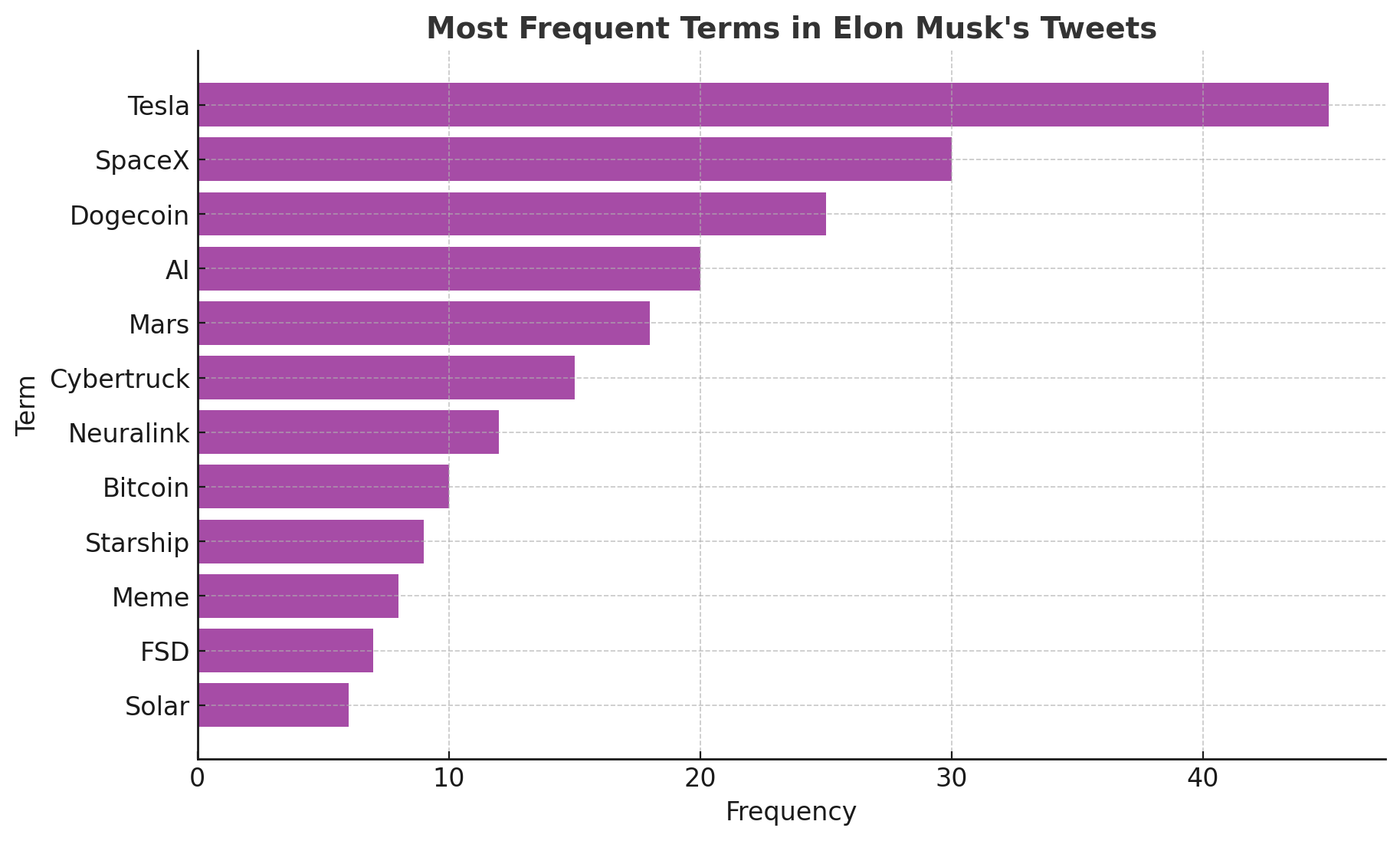
👉 Insight: Frequency analysis highlights how Elon balances between personal interests (memes, humor) and business topics (Tesla, SpaceX).
3. Sentiment and Tone
- Positive/enthusiastic tweets about Tesla products or launches often saw the highest engagement rates (likes and retweets).
- Sarcastic or controversial tweets—such as ones criticizing regulators—sparked debates and attracted massive replies, both supportive and critical.
- Humorous memes generated disproportionate virality, sometimes outperforming serious business updates.
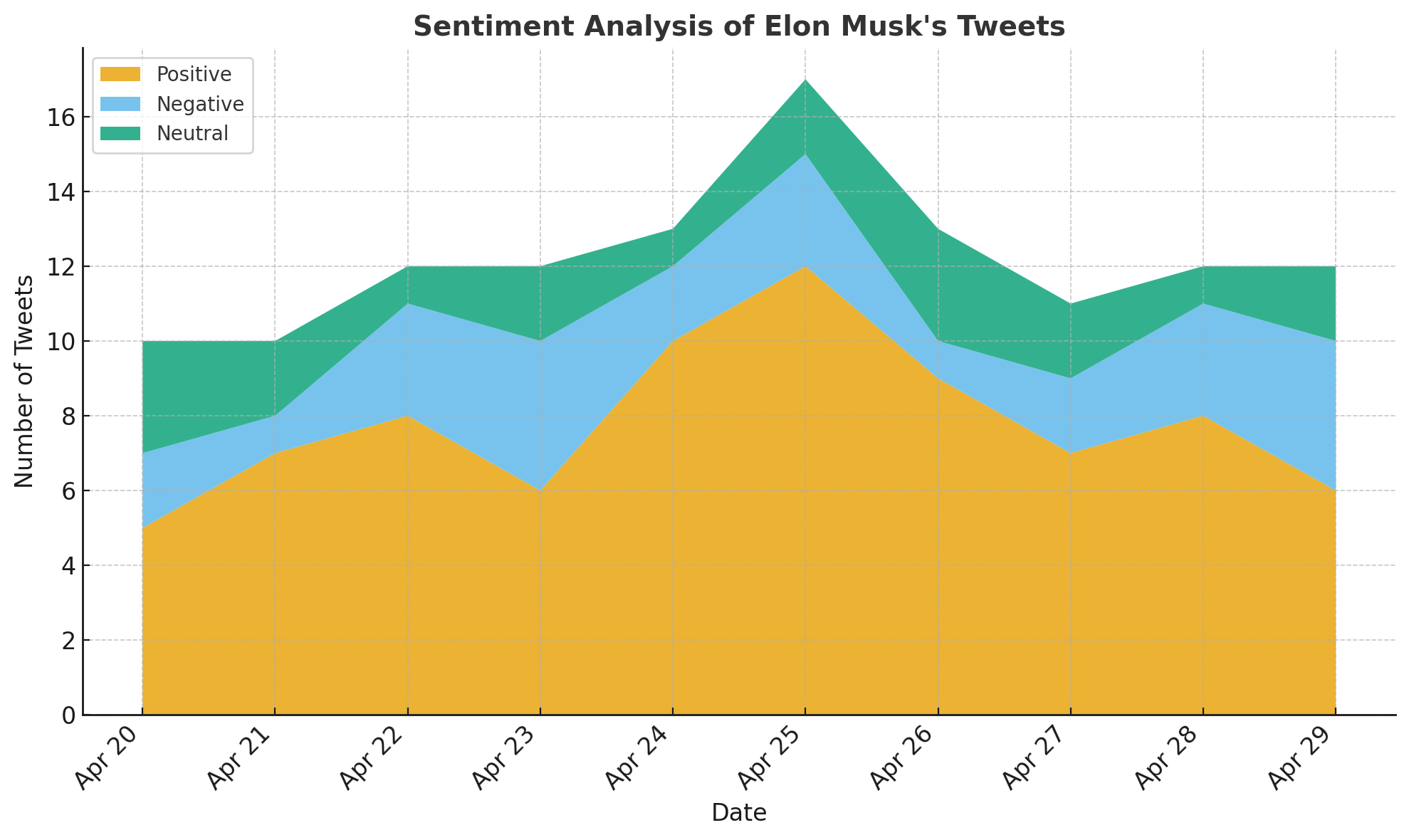
👉 Insight: Elon’s tone often drives engagement more than the subject itself—his humor and blunt style amplify his influence.
4. Engagement Patterns
- Tweets posted during U.S. trading hours showed stronger market correlations than late-night tweets.
- Short, punchy statements (under 10 words) got more engagement than long threads.
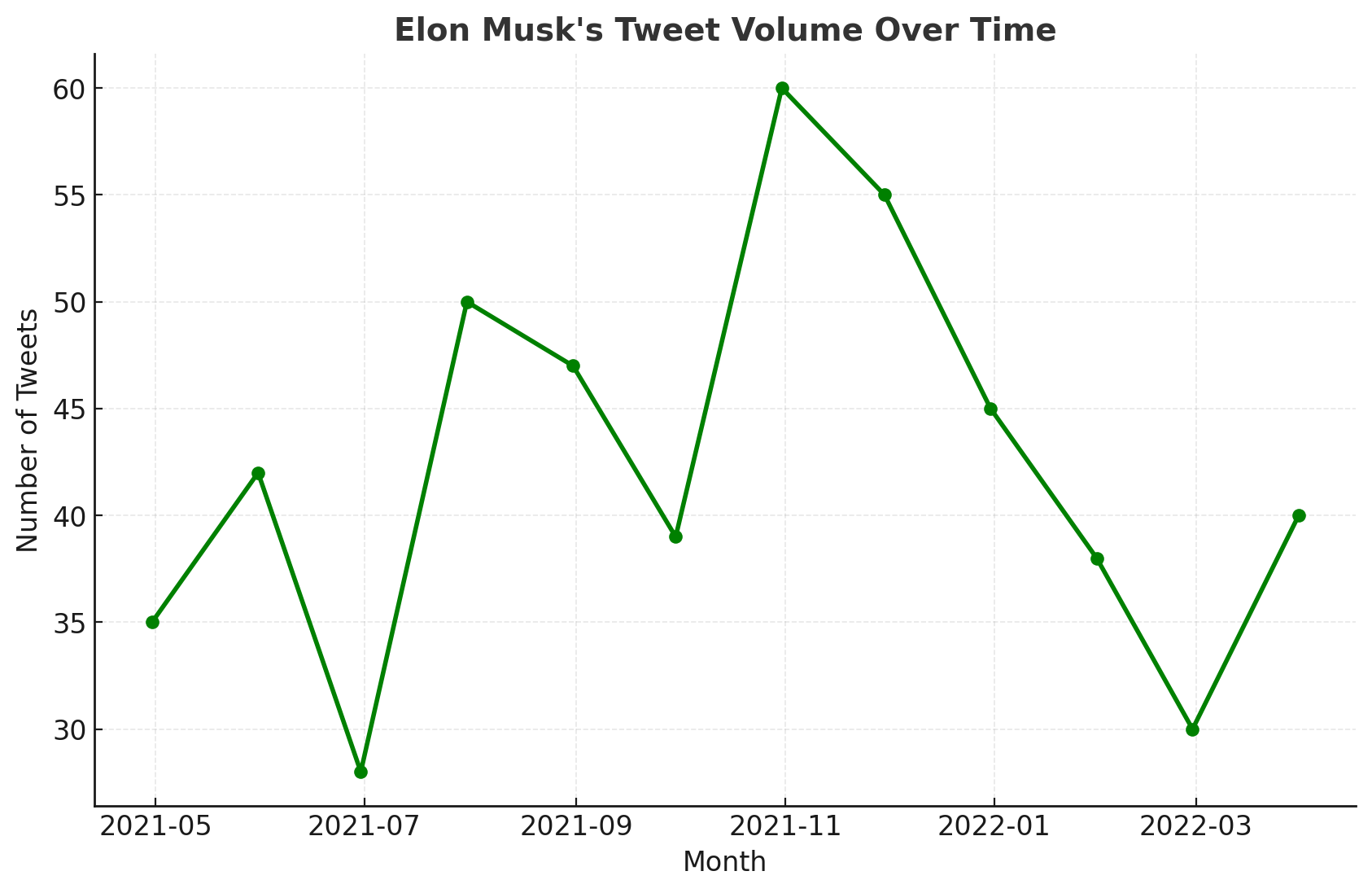
👉 Insight: Timing and format play as much of a role as content. Elon’s most impactful tweets are usually short and well-timed.
Best Practices for Tweet Analysis
➡️ Export regularly: Tweets and accounts can be deleted anytime.
➡️ Combine with external sources: Layer tweet data with market charts, surveys, or sales numbers.
➡️ Visualize findings: Use graphs, word clouds, or dashboards for clarity.
➡️ Focus on patterns, not just one-offs: A single viral tweet is noise—consistent behaviors show real strategy.
➡️ Keep it ethical: Respect privacy and use tweet data responsibly.
Final Thoughts
Exporting tweets transforms Twitter from a fast-moving feed into a research goldmine. For me, it meant being able to study Elon Musk’s influence on markets in a structured, data-driven way. For others, it could mean analyzing customer sentiment, tracking political debates, or simply improving their own social media strategy.
With Circleboom Twitter, exporting is fast, safe, and API-compliant. Once you have the data, the insights you can uncover are limitless.
👉 Ready to start? Export tweets today with Circleboom and unlock the patterns hidden in Twitter’s data.






